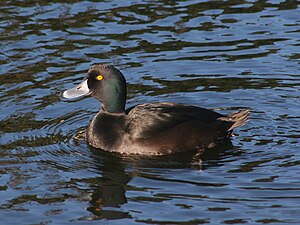New Zealand Scaup
From Wikipedia, the free encyclopedia
The
New Zealand Scaup (
Aythya novaeseelandiae) commonly known as a Black teal, is a
diving duck species of the genus
Aythya. It is
endemic to
New Zealand. In Maori commonly known as papango, also matapouri, titiporangi, raipo
[1].
[edit] Description
Overall dark brown/black colours. The male has a striking yellow eye and a dark coloured (greenish) head. The female is similar to the male, but without the yellow eye and has a white face patch during breeding season. A white wing bar can be seen in both sexes when in flight
[2].
[edit] Feeding
They are a diving duck and may stay down for twenty to thirty seconds and go down three metres to look for aquatic plants, small fish, water snails, mussels and insects
[3][4]. It is sometimes seen with the Australian Coot (
Fulica atra); it is thought that the Scaup takes advantage of the food stirred up by the Coots as they fossick for shrimps.
[4]
[edit] Distribution
Found throughout both North and South islands of New Zealand in deep freshwater lakes and ponds
[2]. Unlike other members of this genus this scaup is not migratory, although it does move to open water from high country lakes if they become frozen in winter.
[4]
[edit] Life cycle
They nest from October to March. They lay five to eight cream/white eggs in a nest close to water, often under banks or thick cover. The nest is usually lined with grass and down
[2]. The eggs are incubated for four weeks by the female. The newly hatched duckling take to diving for food on their first outing.
[4]



No comments:
Post a Comment